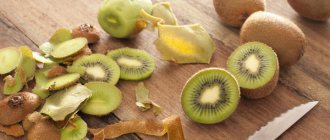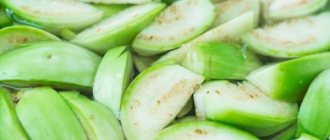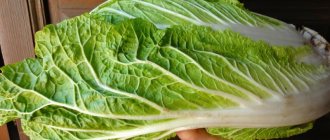You can prepare delicious and original dishes from eggplants, and use them as one of the ingredients in recipes for a wide variety of cuisines. However, in addition to its taste, this vegetable is also valued for its invaluable benefits to the body. Doctors recommend eggplants for dietary nutrition. They have a positive effect on the functioning of the digestive system, remove cholesterol, and bring weight back to normal. And the “little blue ones” are good for bones, skin and hair, the nervous, circulatory, cardiovascular and genitourinary systems.
How to choose eggplants
When purchasing vegetables, you need to pay attention to its size and appearance. The coloring should be uniform, the surface should be smooth, glossy, and elastic. A fresh stalk and adjacent sepals indicate that the crop has recently been harvested from the garden. If the fruit is wrinkled or rotten, it is not worth buying.
The size of the fruit should be chosen based on your preferences. Thin eggplants are well suited for frying into slices, while thick ones can be used as a base for baking or when making rolls. It is also important to pay attention to the maturity of the fetus. The older it is, the more bitter the food will be.
Cleaning after cooking
- Sometimes eggplants are peeled after cooking. First, they are baked in the oven in an unpeeled state, and then cleaned.
- They can also be boiled in boiling water, after which the skin will be easier to remove.
- To remove the peel better, you need to wait until the vegetable cools completely. Peel the eggplant using a knife. The top layer will be removed without pulp.
- After heat treatment, the vegetable can soften well. After this, you can clean it simply with your hands or using a fork. These eggplants can be added to stews or stuffed.
Eggplants can be a wonderful stand-alone dish or a component of another. To avoid bitterness, you need to learn how to choose and cook them correctly. If the fruits are young, they do not need to be peeled. For those who are overripe, this procedure is mandatory.
how to remove bitterness from eggplant before cooking
Do I need to peel eggplants before cooking?
The peel of the eggplant is suitable for food and does not contain anything harmful to humans. It is peeled off to reduce bitterness in the finished dish. Ripe seeds and the outer layer contain substances that taste astringent. Therefore, the fastest way to prepare a vegetable is peeling.
Advice!
A proven way to get rid of bitterness is to soak the slices in salt water.
To remove the outer layer, use a sharp knife or a special vegetable peeler. You can also discard overripe seeds. They are taken out with a knife or spoon.
Method 2 - in salt water
You can soak eggplants in salt whole or in pieces. To prepare a saline solution, use 1 liter of cold drinking water and 1 tablespoon of salt.
It takes at least two hours for the bitterness to leave the whole fruit. It goes away from the pieces in about 30 minutes.
How to do this correctly?
- Wash eggplants well before cooking.
- Each is cut into round or longitudinal slices, cubes or in another way specified in the recipe.
- Place in a bowl of salted water.
- Press down from above with pressure so that they do not float up.
- Then rinse with fresh water and place on a towel to remove excess moisture.
We recommend: Why you shouldn’t pour water out from under pasta - analysis of life hacks from the Internet
Is it always necessary to peel the fruit completely?
Whether to peel eggplants or not is a question that everyone answers for themselves. If the dish is to be savory, the peel can be left on. And when the food must be tender, it is better to cut off the skin and remove the seeds.
Sometimes, eggplants are not peeled whole, but in longitudinal strips. In this case, the bitterness is significantly reduced, but the slices continue to retain their shape well during heat treatment.
Young fruits are not deseeded because they are soft and tasty. But, such eggplants can be peeled if necessary for a culinary project. It is important to remember that the thin skin does not have a pronounced bitter taste, and it is permissible to leave it.
To clean or not
A novice housewife, having bought the “little blue” ones, wonders whether the eggplants need to be peeled or cooked with the skin on. What if such a procedure deprives the vegetable of most of its beneficial properties? Let's figure it out.
When it is necessary
For dishes with eggplants, in which the consistency should be uniform, the vegetables are always peeled, and, if necessary, the core and seeds are removed (if the fruit is old). The seeds of the old fruit spoil the dish, especially when stewing. Stews, mashed potatoes, caviar and stewed eggplants require a delicate consistency - both separately and together with other vegetables.
When not to clean
In some dishes, the “blue” ones must keep their shape after cooking. It is the skin that helps preserve the appearance of the finished product. Eggplants are also left with the skin and seeds or partially peeled when you want them to add a spicy kick to the taste. Such dishes include baked, fried, stuffed and grilled eggplant and vegetable rolls.
Getting rid of bitterness
When a recipe calls for preserving the skin of a vegetable, but there is a risk that it will taste bitter, eggplants require pre-processing. After washing, they are dried, cut into circles or cubes and soaked in salted water (1 l/2 tbsp) for 25-30 minutes . You can also soak it in fresh milk, under slight pressure, for half an hour. The whole fruit will have to be soaked for at least two hours. Then the eggplant is washed with clean water. Now the vegetable can be cooked, and it will not taste bitter.
By the way ! Did you know that it is not the eggplant peel that is most bitter, but its pulp or seeds? That is why, in order to remove it, the vegetable is cut before soaking.
When not to peel vegetables
Old and overripe eggplants need to be peeled for any dish. However, many snacks require the skin to be on the slices. In this case, the algorithm of actions is as follows:
- Choose the youngest vegetables.
- Wash them and dry with a towel.
- Cut into circles or cubes.
- Soak in salt water for 30 minutes.
- Rinse with clean water.
- The cutting is ready for further culinary manipulations.
Advice!
Before baking or grilling, the vegetable slices are not peeled so that they retain their appetizing shape.
To make it tasty and healthy
If you are wondering whether it is necessary to peel an eggplant, you should know that it is bitter not only and not so much because of the peel. The seeds give the vegetable its bitterness. The pulp itself can be bitter. Solanine contained in fruits is responsible for this - a substance that in large quantities has a harmful effect on the body. And when frying a vegetable, it not only spoils the taste of the dish, but can also cause intoxication. Experienced housewives and cooks can always determine whether the fruits will taste bitter.
To understand whether there is a lot of solanine in eggplant and, accordingly, whether it needs pre-treatment, just cut off a small piece of the vegetable and wait half a minute. Eggplant flesh that contains no or very little solanine will remain light in color or may acquire a slightly yellow tint. Vegetables containing a harmful substance darken and turn brown when cut.
To completely remove bitterness, and therefore get rid of solanine, you need to properly process the “little blue” ones:
- cut the eggplant as required by the recipe (you can process the whole eggplant if necessary);
- soak in salted water or milk (30 minutes for cut fruits, two hours for whole ones);
- Remove seeds and peel from the fruit (in whole or in part).
By the way ! Nowadays, most varieties of eggplant are no longer bitter. All thanks to the breeders: they tried hard and developed varieties that simply are not bitter.
What dishes are eggplants used for?
Before preparing a vegetable stew or stew, the eggplants must be peeled. Then you get a delicate, more homogeneous consistency. To obtain caviar or puree, the skin is also removed.
It is important to peel the vegetable for baby and diet food. The outer layer of the fruit accumulates nitrates and other chemicals used on farms. It is harmful for children to use these substances.
No harm with the peel
The peel of a high-quality vegetable that is not overloaded with nitrates will not cause harm to the body. Therefore, there is no question as to whether it can be eaten with the skin. On the contrary, the skin contains a maximum of useful substances . However, sometimes you still need to get rid of the skin.
So, the peel is always peeled if the eggplant is not young: older fruits have a tough skin and will have more bitterness. If vegetables are used for dietary purposes or in dishes for children, it is also better to remove the skin. This especially applies to situations when you purchase vegetables grown in large farms and do not know whether nitrates were used and in what quantities. If there is a suspicion that the fruit was grown with the use of chemicals, it is better to get rid of the skin, as it tends to accumulate harmful toxins.
Adviсe
Housewives are constantly improving their skills and sharing their discoveries with each other. Tricks for cleaning the “little blue”:
- The area near the “stem” is usually hard and bitter, so it is cut off even if you do not plan to peel the whole fruit. Do the same with the lower tip.
- The skin can be removed from the finished vegetable (while warm), if necessary for aesthetic serving. But, in this case, the dish may be slightly bitter.
- If you use your imagination, you can get a “striped” eggplant - by peeling not all the skin, but only strips. This approach will help to interest children in its unusual appearance.
Beneficial properties of the skin
The peel contains almost all the microelements that the vegetable itself contains. It contains:
vitamins C, B, P, D;
- phosphorus;
- sulfur;
- potassium;
- magnesium;
- calcium;
- zinc;
- fluorine;
- cellulose;
- pectin, etc.
Thanks to these substances and elements, the product brings significant benefits to the body:
- helps eliminate excess cholesterol;
- preventing the occurrence of atherosclerosis and heart disease; accelerates the process of hematopoiesis;
- strengthens bones;
- increases the elasticity of blood vessels;
- normalizes intestinal activity;
- reduces weight.
The harm of the vegetable, as already mentioned, lies in the solanine it contains. Its excess leads to poisoning, so those who have gastrointestinal diseases should handle this product very carefully. A significant part of this substance is contained in the peel, which somewhat reduces its nutritional value.
But in the absence of significant health problems, eggplant can be eaten with the skin - there will be no harm. In addition, the effects of solanine can be neutralized by soaking it in a saline solution or stewing it. This means that peeling is not necessary.
Signs of solanine
In addition, peeled eggplant does not retain its beneficial properties for long. The peel protects the vegetable from drying out, and it also withers and rots less. Therefore, if you decide to remove the skin, you should do this immediately before preparing the product.
However, there are cases in which it is necessary to peel the product. This is influenced by the plant variety, its degree of maturity and the characteristics of the planned preparation. You need to peel this vegetable in the following situations:
- The plant variety is characterized by a pronounced bitter taste. Removing the peel in this case will reduce the bitterness.
- The plant is overripe. Young vegetables contain very little solanine, but if the eggplant is old, the skin should be removed.
The product is not fresh. It is generally risky to eat such vegetables, but if you decide to do so, you need to take all precautions.
- The vegetable skin is too thick. It contains more solanine, and is also more difficult to chew. Although if heat treatment and pre-soaking are planned, the skin can be left.
- The eggplants are going to be fried. When frying, the product becomes filled with cholesterol and loses many of its beneficial properties. So it's worth trying to reduce the risk by removing the skin before frying.
However, in general, the question of peeling this fruit must be decided by everyone independently. Everyone's taste preferences are different and some people like the bitter taste that the vegetable develops when the peel is preserved.
Another important aspect is whether the product needs to be cleaned of seeds. This is also decided individually. The most important thing to consider is the size of the vegetable. The large “blue” ones have large enough seeds that they can be cut out. If the size of the vegetable is small, such manipulations are meaningless. There is almost no solanine in small seeds, but there are a lot of useful substances, so it is better to leave them.
Incomplete cleaning
There is another interesting method in which the peel is partially removed from eggplants, that is, in strips. The method is interesting because the vegetables retain their shape during heat treatment, and the finished eggplants take on an unusual and attractive appearance. You must first wash the eggplants, cut off the stem and peel them in strips of equal width (about 2-3 cm, depending on the size of the vegetables). If the baked eggplant is very soft, you can remove the skin simply with your fingers or a spoon.
- Author: Maria Sukhorukikh
Rate this article:
- 5
- 4
- 3
- 2
- 1
(0 votes, average: 0 out of 5)
Share with your friends!
Method 4 - by removing seeds
There is a version that it is the eggplant seeds that are bitter, because their shape resembles pepper seeds.
When there is no time for soaking, cooks remove the seeds:
- the vegetable is washed well;
- cut lengthwise with a sharp knife;
- scrape out the seeds with a spoon (as far as possible);
- rinse and dry with paper towels.
First method: salt treatment
Each housewife uses her own method, repeatedly tested and loved. In this article we will talk about the most famous methods of how to get rid of bitterness from eggplants. So, the first method is salt treatment. We take the vegetables prepared for processing, wash them well, and cut off the tails. Depending on the type of dish, cut the vegetable into slices or circles.
Place in a bowl (preferably deep), rub with coarse salt and leave them alone for 20 minutes. If you need whole “little blue ones,” then the marinating time can reach an hour. As the salt dissolves, droplets of liquid will begin to appear on the eggplants. After the specified time, all that remains is to rinse our vegetables well under cold running water and use them for their intended purpose. The first option on how to remove bitterness from eggplants has been mastered. It's the simplest. By the way, you can not rinse the vegetables with water, but simply squeeze them out.
Video about peeling eggplants
Now you know how to properly peel eggplant for various dishes. We hope our tips helped you. Share your thoughts on this topic with us and our readers in the comments. Bon appetit and comfort to your home!
- Author: Svetlana Grishkina
Good afternoon My name is Svetlana. This site has become for me not only an additional source of income, but also an opportunity to share with you my knowledge in housekeeping. Rate this article: (27 votes, average: 3.5 out of 5)
Who to choose as
To ensure that the dish turns out delicious, you need to manage to choose the ingredients. First you need to decide how exactly your sister will cook the eggplants. They can not only be simply boiled or fried, but also canned.
If according to the recipe the blue ones are prepared with the peel, then it must be young. Such eggplants, when prepared, will be unimportant (= unimportant) bitter, and they will not contain a substance called solanine, which is classified as a poison in large quantities. These vegetables cannot be disposed of raw.
When choosing vegetables, you need to look at their shell, coloring and determine the degree of softness. It is best to purchase eggplants with the following characteristics.
- strong;
- The (foreskin) flesh should be soft and elastic;
- there are probably no stains or defects on it;
- high-quality eggplants have a dark-light purple color.
If they are soft and have wrinkled skin, then they contain a lot of solanine. It is better to buy such eggplants at a disadvantage. It is also not recommended to choose large fruits, on average as this is a sign that they are overripe. Such vegetables will also taste bitter.











